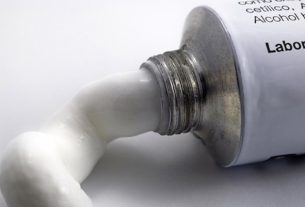Amoxicillin + clavulanate is an antibiotic that works to eliminate bacteria that cause infections such as pneumonia, ear infections, bronchitis, sinusitis, urinary or skin infections, for example.
Amoxicillin + clavulanate is available in pharmacies and drugstores, found in the form of tablets or suspension, administered orally, under the trade name Clavulin or Clavulin BD, or in generic form under the name amoxicillin and clavulanate potassium, or with the similar names Novamox, Atak Clav or Sigma Clav.
This medication is only sold with a medical prescription and prescription retention by the pharmacy. This antibiotic can also be found in injection form and is only used in hospitals, under the supervision of a healthcare professional.
What is it for
Amoxicillin + clavulanate is indicated for the treatment of bacterial infections, such as:
- Pneumonia or bronchopneumonia;
- Acute or chronic bronchitis,
- Sinusitis;
- Plague;
- Pharyngitis or tonsillitis;
- Skin infections, such as boils, abscesses or infected wounds;
- Erysipelas;
- Diabetic foot;
- Pelvic inflammatory disease;
- Urinary tract infection, such as cystitis, urethritis or pyelonephritis;
- Infection in the bones or joints, such as osteomyelitis.
Furthermore, amoxicillin + clavulanate may also be recommended by dentists in case of tooth infection.
The use of amoxicillin + clavulanate must be carried out with medical advice, in doses and for the duration of treatment recommended by the doctor.
How it works
This antibiotic combines amoxicillin, which fights bacteria, and clavulanate, also called clavulanic acid or potassium clavulanate, which inhibits an enzyme in bacteria that can inactivate amoxicillin and, in this way, helps prevent them from becoming resistant, improving the effect on the combat bacteria.
How to drink
Amoxicillin + clavulanate should be taken orally with a glass of water, along with a light, non-greasy meal. It is important to always take it at the time and for the period of time established by the doctor, even if symptoms improve quickly, to avoid the risk of infection resistant to amoxicillin and clavulanate.
1. Amoxicillin + clavulanate tablets
Amoxicillin + clavulanate tablets should be taken whole, without breaking or chewing, as they have a coating to prevent stomach irritation.
These tablets can be used by adults or children over 12 years of age, and the method of use varies depending on the dose of the tablet and includes:
- 500 + 125 mg tablets: 1 tablet every 8 hours;
- 875 + 125 mg tablets: 1 tablet every 12 hours.
The treatment time with amoxicillin + clavulanate may vary according to the type of infection, and medical advice should always be followed.
2. Amoxicillin + clavulanate oral suspension
The oral suspension of amoxicillin + clavulanate 200 mg + 28.5 mg/5 mL can be used by adults or children over 2 months and the dose depends on the type of infection, and the pediatrician should always advise the amount to be taken and the treatment time.
The recommended doses of amoxicillin + clavulanate for adults are:
- Mild to moderate infections (tonsillitis, lower respiratory tract infections or skin infections): the recommended dose is 25/3.6 mg to 45/6.4 mg, per kg of body weight per day, divided into two doses per day, taken in 12 in 12 hours;
- Serious infections (otitis media and sinusitis, bronchopneumonia or urinary infections): the recommended dose is 45/6.4 to 70/10 mg, per kg of body weight per day, divided into two doses per day, taken every 12 hours.
For babies over 2 months of age, doses of amoxicillin + clavulanate must be adjusted by the doctor according to weight and age, to avoid kidney problems and side effects.
How to prepare the suspension
Amoxicillin + clavulanate oral suspension must be prepared before use, as it is sold in powder form and needs to be diluted for use.
Therefore, filtered water and the dosing syringe provided in the packaging must be used to prepare the suspension, adding water to the bottle until it reaches the mark indicated on the label. This suspension must be stored in a refrigerator and is valid for 7 to 10 days, depending on the brand used, and the suspension must be discarded after this expiration date.
The oral suspension must be shaken vigorously before use to mix its components and achieve the expected effect of the treatment, and it is also important to use the dispenser provided to give the correct dose.
What to do if you forget to take it
If you forget to take a dose at the right time, take it as soon as you remember, and then readjust the times according to this last dose, continuing the treatment according to the new scheduled times.
Do not double the dose to make up for a forgotten dose.
Possible side effects
Some of the most common side effects that may occur during treatment with amoxicillin and clavulanate are nausea, vomiting, diarrhea, abdominal pain, itching, redness or formation of small blisters on the skin, candidiasis or vaginal discharge.
Amoxicillin + clavulanate can cause serious allergic reactions that require immediate medical attention. Therefore, you should stop treatment and seek the nearest emergency room if you experience symptoms such as difficulty breathing, coughing, chest pain, a feeling of a closed throat, swelling in the mouth, tongue or face, or hives. Learn more about allergic reaction symptoms.
Immediate medical attention should also be sought if taking amoxicillin + clavulanate in doses greater than those recommended and overdose symptoms such as nausea, vomiting, stomach pain, diarrhea, blistering of the skin, drowsiness, agitation, hyperactivity or decreased the amount of urine.
In addition, you should notify your doctor if you experience severe stomach pain, watery or bloody diarrhea, pale or yellowish skin, dark-colored urine, fever, confusion or weakness, loss of appetite, little or no urine, or bruising. or bleeding.
Who shouldn’t use
Amoxicillin + clavulanate should not be used in the first trimester of pregnancy and, therefore, if a woman becomes pregnant during treatment, she should stop using it and inform the doctor that she is pregnant, so that another antibiotic can be prescribed.
Furthermore, this antibiotic can pass into breast milk in small quantities and cause sensitivity in the baby, and it is important to always inform the doctor that you are breastfeeding so that the benefits and risks of the treatment can be assessed.
This antibiotic should also not be used by people allergic to amoxicillin or clavulanate, other penicillins such as benzathine penicillin, ampicillin, carbenicillin, ticarcillin or piperacillin, cephalosporins such as cefuroxime, cefdinir or cefprozil, or fluoroquinolones such as levofloxacin, for example.
Amoxicillin + clavulanate is not recommended for children under 2 months of age, people with kidney problems or those undergoing hemodialysis, or liver diseases such as liver failure or hepatitis, or people using other medications such as allopurinol, probenecid, acenocoumarol, warfarin or mycophenolate mofetil.
Furthermore, amoxicillin + clavulanate can reduce the effect of oral contraceptive pills, and it is recommended to use another method to prevent pregnancy, such as a condom or diaphragm, for example, during treatment with this antibiotic.

Sign up for our newsletter and stay up to date with exclusive news
that can transform your routine!
Warning: Undefined array key "title" in /home/storelat/public_html/wp-content/plugins/link-whisper-premium/templates/frontend/related-posts.php on line 12
Warning: Undefined array key "title_tag" in /home/storelat/public_html/wp-content/plugins/link-whisper-premium/templates/frontend/related-posts.php on line 13




